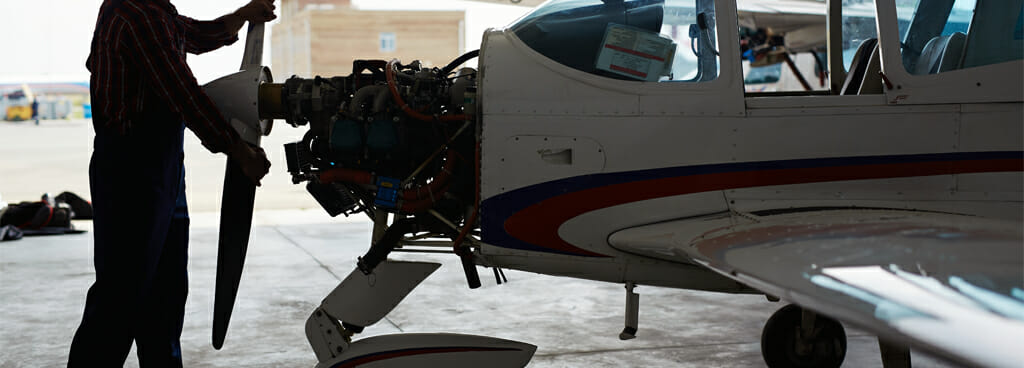- Home
- Services/IndustriesServicesindustries
- About Us
- LocationsStatesAccordion ContentAccordion ContentAccordion ContentAccordion Content
- Job Openings
- Quick Links
- ATS Family

MSB96-10B: Preventing Crankshaft Failure
Applied Technical Services inspects aircraft engines for signs of crankshaft failure in accordance with the MSB96-10B standard for airworthiness. Small, general-use aircraft tend to use a reciprocating engine, also known as a piston engine. These subsystems produce the energy that rotates the propeller and generates lift for the aircraft. The crankshaft, like in land-faring vehicles, represents one of the most integral components of a functioning piston engine — if the crankshaft fails, the engine fails soon after.
When Continental Motors determined that a class of piston engines was prone to cracking in their crankshafts, they issued a mandatory service bulletin (MSB) to ensure the safety of affected aviators. The next year, the Federal Aviation Administration (FAA) determined that the reliability of these same models were compromised due to ineffective manufacturing processes for their crankshafts; they created an airworthiness directive (AD) requiring that affected aircraft replace the defective components. Both these standards demanded that the operators of aircraft featuring the engines in question submit their crankshafts for a specific type of nondestructive inspection every time they are to be installed.
As noncompliance with applicable ADs often results in being grounded, owners and operators of affected aircraft seek out the help of inspectors with experience serving the aviation industry, such as ATS.
What MSB96-10B and FAA AD 97-26-17 Apply To
MSB96-10B and FAA AD 97-26-17 both require a UT inspection for subsurface fatigue cracks that form below the intermediate main bearing fillets. It applies every time the crankshaft is removed, whether for routine inspection or overhaul, mandating a UT inspection on areas of concern before placing it back into the crankcase. Only qualified Level II technicians (recognized by either ASNT or MIL-STD-410 or an FAA-approved equivalent) may perform this inspection. Any crankshaft that fails inspection or was not verifiably manufactured using the vacuum arc remelt (VAR) method must be immediately replaced with a passing crankshaft.
How ATS Can Help
Our Level II UT technicians, each licensed and recognized according to ASNT’s SNT-TC-1A, regularly perform this NDT method to detect at- and near-surface discontinuities too small to see with the naked eye. ATS’ aviation NDT specialists bring cumulative decades of experience using this method to help determine the airworthiness of client craft. Our Greenville and Chesapeake locations maintain registration as FAA-certified repair stations (numbers HC4R227M and QPVR455X, respectively), while our Marietta headquarters (FAA certification number HC4D227M) also bears the distinctions of being approved under EASA part-145 and Nadcap accredited to perform a variety of NDT methods on client aircraft.
About Applied Technical Services
Founded in 1967, Applied Technical Services offers expert inspection, testing, and consulting engineering capabilities to clients from a range of industries. Our 50+ years in business have allowed our company to expand its list of services and deepen its pool of expertise; once a trio of engineers meeting the needs of local businesses from their office stuffed into our founder’s basement, ATS now constitutes a multidisciplinary firm providing the services of over 1,000 inspectors, forensic investigators, technicians, calibrators, chemists, trainers, and scientists to companies operating around the globe. Of the many industries we work alongside, our ability to verify compliance with MSB96-10B and FAA AD-97-26-17 solely benefits aviation clients.
Committed to Quality
We perform all aviation inspection services in accordance with our ISO 9001 quality management system — registered to ISO 9001. To ensure clients enjoy the best possible experience working with our company, ATS upholds the following policies:
- Inspectors return their findings quickly to give clients the information they need to make informed, timely decisions
- They produce clear, accurate, and detailed reporting by complying with all applicable standards
- Customer service representatives receive clients asking for clarification on the status or results of their inspection
- These relationship specialists facilitate contact with the most relevant staff member
- Technicians are accessible to clients who reach out with questions
- These subject matter experts remain responsive and engaged while assisting clients in solving their problems
If your aircraft needs UT inspection to comply with MSB96-10B and FAA AD 97-26-17 safety standards, contact ATS today for a free quote — We take a closer look!

Request Form
"*" indicates required fields
